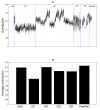An improved classification of G-protein-coupled receptors using sequence-derived features
- PMID: 20696050
- PMCID: PMC3247138
- DOI: 10.1186/1471-2105-11-420
An improved classification of G-protein-coupled receptors using sequence-derived features
Abstract
Background: G-protein-coupled receptors (GPCRs) play a key role in diverse physiological processes and are the targets of almost two-thirds of the marketed drugs. The 3 D structures of GPCRs are largely unavailable; however, a large number of GPCR primary sequences are known. To facilitate the identification and characterization of novel receptors, it is therefore very valuable to develop a computational method to accurately predict GPCRs from the protein primary sequences.
Results: We propose a new method called PCA-GPCR, to predict GPCRs using a comprehensive set of 1497 sequence-derived features. The principal component analysis is first employed to reduce the dimension of the feature space to 32. Then, the resulting 32-dimensional feature vectors are fed into a simple yet powerful classification algorithm, called intimate sorting, to predict GPCRs at five levels. The prediction at the first level determines whether a protein is a GPCR or a non-GPCR. If it is predicted to be a GPCR, then it will be further predicted into certain family, subfamily, sub-subfamily and subtype by the classifiers at the second, third, fourth, and fifth levels, respectively. To train the classifiers applied at five levels, a non-redundant dataset is carefully constructed, which contains 3178, 1589, 4772, 4924, and 2741 protein sequences at the respective levels. Jackknife tests on this training dataset show that the overall accuracies of PCA-GPCR at five levels (from the first to the fifth) can achieve up to 99.5%, 88.8%, 80.47%, 80.3%, and 92.34%, respectively. We further perform predictions on a dataset of 1238 GPCRs at the second level, and on another two datasets of 167 and 566 GPCRs respectively at the fourth level. The overall prediction accuracies of our method are consistently higher than those of the existing methods to be compared.
Conclusions: The comprehensive set of 1497 features is believed to be capable of capturing information about amino acid composition, sequence order as well as various physicochemical properties of proteins. Therefore, high accuracies are achieved when predicting GPCRs at all the five levels with our proposed method.
Figures





Similar articles
-
GPCR-PEnDB: a database of protein sequences and derived features to facilitate prediction and classification of G protein-coupled receptors.Database (Oxford). 2020 Nov 20;2020:baaa087. doi: 10.1093/database/baaa087. Database (Oxford). 2020. PMID: 33216895 Free PMC article.
-
GPCR-MPredictor: multi-level prediction of G protein-coupled receptors using genetic ensemble.Amino Acids. 2012 May;42(5):1809-23. doi: 10.1007/s00726-011-0902-6. Epub 2011 Apr 20. Amino Acids. 2012. PMID: 21505826
-
Classifying G-protein-coupled receptors to the finest subtype level.Biochem Biophys Res Commun. 2013 Sep 20;439(2):303-8. doi: 10.1016/j.bbrc.2013.08.023. Epub 2013 Aug 20. Biochem Biophys Res Commun. 2013. PMID: 23973783
-
Bioinformatics tools for predicting GPCR gene functions.Adv Exp Med Biol. 2014;796:205-24. doi: 10.1007/978-94-007-7423-0_10. Adv Exp Med Biol. 2014. PMID: 24158807 Review.
-
Present perspectives on the automated classification of the G-protein coupled receptors (GPCRs) at the protein sequence level.Curr Top Med Chem. 2011;11(15):1994-2009. doi: 10.2174/156802611796391221. Curr Top Med Chem. 2011. PMID: 21470173 Review.
Cited by
-
GPCR-PEnDB: a database of protein sequences and derived features to facilitate prediction and classification of G protein-coupled receptors.Database (Oxford). 2020 Nov 20;2020:baaa087. doi: 10.1093/database/baaa087. Database (Oxford). 2020. PMID: 33216895 Free PMC article.
-
The Evolutionary History of Vertebrate Adhesion GPCRs and Its Implication on Their Classification.Int J Mol Sci. 2021 Oct 30;22(21):11803. doi: 10.3390/ijms222111803. Int J Mol Sci. 2021. PMID: 34769233 Free PMC article.
-
Revisiting the classification of adhesion GPCRs.Ann N Y Acad Sci. 2019 Nov;1456(1):80-95. doi: 10.1111/nyas.14192. Epub 2019 Jul 31. Ann N Y Acad Sci. 2019. PMID: 31365134 Free PMC article.
-
A survey of computational intelligence techniques in protein function prediction.Int J Proteomics. 2014;2014:845479. doi: 10.1155/2014/845479. Epub 2014 Dec 11. Int J Proteomics. 2014. PMID: 25574395 Free PMC article. Review.
-
Ion-pumping microbial rhodopsin protein classification by machine learning approach.BMC Bioinformatics. 2023 Jan 27;24(1):29. doi: 10.1186/s12859-023-05138-x. BMC Bioinformatics. 2023. PMID: 36707759 Free PMC article.
References
Publication types
MeSH terms
Substances
LinkOut - more resources
Full Text Sources
Other Literature Sources

